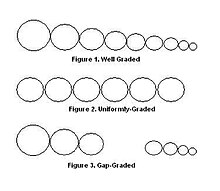Introduction
editSoil gradation is an important aspect of geotechnical engineering. It is an indicator of other engineering properties such as compressibility, shear strength, and hydraulic conductivity.[1] In a design, the gradation of the in situ or on site soil often controls the design and ground water drainage of the site. When a fill material is being selected for a project such as a highway embankment or earthen dam, the soil gradation is considered. These types of projects may also have gradation requirements that must be met before the soil to be used is accepted. When options for ground remediation techniques are being selected, the soil gradation is a controlling factor. [2] [3] [4] [5]

Introduction
editSoil Gradations
edit- Well Graded
- Poorly Graded
- Uniformly-Graded
- Gap-Graded
Measurement Techniques
editEquations
editReferences
edit- ^ "ASTM D6913 - 04(2009)".ASTM International. ASTM International. 1996-2009. October 13, 2009. <http://www.astm.org/Standards/D6913.htm>
- ^ Holtz, R. and Kovacs, W. (1981), An Introduction to Geotechnical Engineering, Prentice-Hall, Inc. ISBN 0-13-484394-0
- ^ “Sieve Analysis and Particle Analysis”. Grand Solution Manual. SJ Soft Technologies. 2008. October 13, 2009. http://www.aboutcivil.com/Sieve-analysis-and-soil-classification.html
- ^ “Sieve Analysis”. Integrated Publishing. Integrated Publishing. 2003-2007. October 13, 2009. http://www.tpub.com/content/engine/14080/css/14080_127.htm
- ^ “Soil Gradation”. Integrated Publishing. Integrated Publishing. 2003-2007. October 13, 2009. http://www.tpub.com/content/engine/14081/css/14081_454.htm